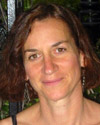 Leigh H. Royden |
2011 George P. Woollard Award
Presented to William A. Dimichele
Citation by Walter D. Mooney
Prof. Leigh (Wiki) H. Royden of MIT has been selected as the 2011 Woollard Awardee by the Geophysics Division. Wiki has made major contributions to the study of geologic processes through quantitative geophysical modeling. A native of Palo Alto, California, her father, Halsey Royden, was a math professor at Stanford University. Wiki’s interest in a quantitative approach to science may have been inspired by him. She completed her A.B. degree (physics) at Harvard and received her Ph.D. at MIT in 1982. She is the recipient of numerous awards, including a Presidential Young Investigator Award in 1985, the Donath Medal (Young Scientist Award) from the GSA in 1990, and election to Fellowship of the AGU in 2004. This Geophysical Division award recognizes Wiki’s impressive scientific achievements and I highlight just a few these. Certainly one of Wiki’s first big scientific contributions was her paper on the thermal subsidence of the rifted continental margin of NE North America. Today we view the process of thermal subsidence as so familiar that it is sometimes forgotten that this two-stage process was developed and quantified in this now-classic paper. A second landmark paper is entitled “Evolution of retreating subduction boundaries formed during continental collision” (Royden, 1993). Wiki applied her analysis to the Mediterranean region, easily one of the most complex tectonic environments on Earth. Wiki was the first to recognize the critical role played by advancing and retreating plate boundaries during collisional events. Wiki is also well recognized for her work on the channelized flow of a weak crustal layer (Royden, JGR, 1996; Clark and Royden, Geology, 2000). Wiki’s contribution was to provide the mathematical background for basally driven three-dimensional flow within an idealized crust with a laterally invariant, depth-dependent Newtonian viscosity. One impressive outcome of her calculations was the demonstration that a steep-sided, flat-topped plateau is expected in the case of a crust with a low-viscosity zone, exactly as is observed in Tibet and the Altiplano. Entire conferences have been devoted to a discussion of crustal channel flow, and the Geological Society of London published a multi-author book on the topic. Wiki has been a frequent speaker at GSA meetings and has been a highly successful mentor. As a final note, I have observed that Wiki is frequently selected as a keynote speaker at the conferences she attends. After her talk, the scientific discussion inevitably ends up centered on the ideas she has introduced. She’s a person who captures an audience’s scientific imagination. For all of these reasons it is a great pleasure to present Wiki Royden of MIT with the 2011 Woollard Award from the Geophysics Division of the GSA.
 2011 George P. Woollard Award — Response by Leigh H. Royden
2011 George P. Woollard Award — Response by Leigh H. Royden
It is a great honor to receive the George P. Woollard Award for Geophysics, and I thank you all very much. I especially want to thank Tom Jordan and Walter Mooney for their efforts to compose and deliver a most flattering citation. I have been extremely fortunate to have had many excellent colleagues, collaborators and students, who are far too numerous to mention here, but I must single out just a few.
First and foremost, I would like to thank John Sclater for luring me into the general field of geophysics, persuading me to apply to the PhD program at MIT, and as my PhD advisor leaving to go on sabbatical for my first year of graduate school so that I was left on my own to discover that geology was at least as interesting as geophysics. I must also thank Bill Brace who hired me as an assistant professor at MIT, and Tom Jordan who sheparded my tenure case through the perils of the MIT Science Council. Finally, I thank Clark Burchfiel, who taught me most of what I know about geology, and even more about geology that I have forgotten.
When I was young, I was frequently asked whether I considered myself to be a geologist or a geophysicist, but I never could decide which I was. Now that I am farther down the road of aging geoscientist, I am no longer asked this question very often. Instead, geologists assume that I am a geophysicist and geophysicists assume that I am a geologist. I am not at all sure that this is particularly flattering but I hope that receipt of the Woollard Award will clarify this point—I am officially a geophysicist/ …. or maybe still not?
Lastly, on this auspicious anniversary of the Geophysics Division of the GSA, I would like bear in mind the sage advice of George Thompson, the first-ever recipient of the GSA’s Woollard Award. George was the first to write and congratulate me, and as we exchanged emails reminded me that the best way to give a five minute acceptance speech is to stop after four minutes. And with that sound advice in mind, I shall end by thanking you all once again for this very great honor.
